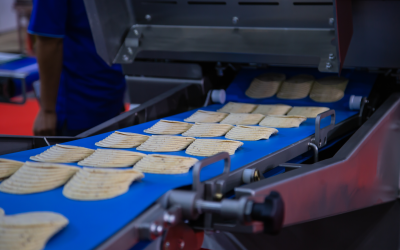Gary C. Smith, Colorado State University
Presence of unwanted “foreign” (i.e., not characteristically present) or “extraneous” (i.e., coming from without) material in food can constitute health and/or quality concerns. Depending on the size and shape of the object, it may cause choking, injury in the mouth, or other health effects, in which case it is deemed a “Physical Food Safety Hazard” in both USDA HACCP1 and FDA PCHF2 regulations as well as GFSI standards.3,4 In all of the Regulations and Standards, there are documented policies, procedures, and handling requirements for the control of foreign materials plus the use of detection and removal equipment to find, reduce, or eliminate the risk of foreign-body contamination.
What is a “Physical Hazard” in Food?
Both Agencies have codified, through inclusion in their Code of Federal Regulations documents, specific “Physical Hazards.” USDA lists metal, glass, and plastic1; FDA lists metal, glass, and stones.2
Training modules have broadened those lists. One HACCP training class lists as Physical Hazards the 12 most common foreign materials in foods, including the following:5
- Glass
- Wood
- Stones
- Metal
- Jewelry
- Insects
- Bone
- Plastic
- Insulation
- Personal effects
- Bullets/BB shot
- Needles
Another HACCP training class lists the following as Physical Hazards:6
- Glass
- Metal fragments
- Wood
- Wire clips
- Stones
- Needles
A PCHF training class lists the following as Physical Hazards:7
- Glass
- Brittle Plastic
- Metal
- Wood
- Stones
- Choking Hazards For Young Children (soft plastic, cylindrical or compressible foods like hot dogs, sausages, grapes, peanuts, popcorn, and bottle caps from beverages)
GFSI standards add these foreign materials:3,4,8,9
- Ceramics
- Porcelain
- Temporary Fasteners (string, wire, and tape)
What is Foreign Material in Food?
From a regulatory standpoint, there are foreign materials (e.g., hard, sharp, pointed, and shorter than 7mm or longer than 25mm10) and extraneous material (e.g., string, paper, mold, hair, insects, sand, and dirt7,11) that are not considered Food Safety Hazards.
USDA says, “Foreign objects which cannot cause illness or injury are not Hazards, even though they may not be esthetically pleasing to your customers.”6 FDA says, “Establishments should address, in the PCHF Food Safety Plan, only those foreign or extraneous materials that are Hazards reasonably likely to cause injury.”7
FDA and USDA Determine When Something Becomes an “Adulterant”
However, both Agencies can make judgement calls regarding the amount or level at which a extraneous or foreign material in food becomes an “adulterant.”11,12 FDA uses “Action Level” standards for Extraneous Material defects that present no Health Hazard to make decisions on regulatory actions.7 For example, these standards allow no more than: (a) 10 milligrams of animal feces in 1 pound of coffee, or (b) 12% mold, 4 rodent hairs, and 5 whole insects per 3.5 ounces in apple butter.13 GFSI-benchmarked schemes have no regulatory authority, so they just list – with no metrics – foreign materials.
FDA Tasks QC Departments With Reducing Defects to the Lowest Possible Level
Those at the processing/manufacturing level are concerned about complying with federal regulations (to prevent recalls, product withdrawals, and safety alerts), achieving GFSI standards, and meeting customer/consumer expectations. Inadequate product quality, based on “Consumer Displeasure” (i.e., sight and feel “danger” – rooted in odd appearance, irregular mouthfeel, or unexpected texture) can damage brand reputation and loyalty, resulting in economic losses.
“Quality Threats” (i.e., not meeting consumer expectations for size, shape, or appearance of foreign or extraneous defects) necessitate action beyond regulations and standards.14 FDA says, “Quality Control Operations must be used to reduce these defects to the lowest level currently possible.”7 So, no metrics are needed – processors/manufacturers must find and remove them all.
Recalls Due to Extraneous and Foreign Material in Food Increasing
Prior to 2010, so few recalls were associated with Physical Hazards that FDA didn’t even collect the data.15 For 2010-2012, FDA food recalls for Physical Hazards averaged 2.6% of all food recalls; things heated up when FDA started mandating the Reportable Food Registry.7
FSIS-USDA recalls for extraneous and foreign material in food were very low until it issued a Rule in 2012 requiring notification of the Agency within 24 hours if a food is potentially contaminated with foreign objects.16 A few years later, FSIS started requiring that companies notify the Agency if they received consumer complaints about foreign material in USDA-regulated foods.17
In 2016, 11% of FSIS recalls were for extraneous and foreign materials; by 2017, 43% of FSIS recalls were for extraneous and foreign materials.18 Three reasons for that increase included the following:
- Greater focus on those materials by in-plant personnel
- Lower tolerance for extraneous and foreign material in food by customers and consumers
- The litigious nature of foreign and extraneous material19
75% of Food Recalled in 2019 Due to Foreign Material
So, in March 2019, USDA issued a “Best Practice Guideline” for meat and poultry processors to reinforce the 2012 Rule.16 By 2019, it was reported that: (a) foreign material has surged to become the No. 1 cause of recalls in recent years20 and (b) foreign-material contamination accounted for 75% of the total volume of food recalled by FSIS in 2019.21
One HACCP Course identifies “Source or Cause” of Physical Hazards as the following:5
- (1) Glass: bottles, jars, light fixtures, gauge covers, thermometers
- (2) Metal: nuts, bolts, screws, steel wool, wire
- (3) Stones: deteriorating walls, ceilings, floors; in the tread of wheels or workers’ shoes
- (4) Plastics: packaging materials, belts, aprons
- (5) Bone: errors in fabrication, processing, product segregation
- (6) Insects: fields, plant, post-process entry
- (7) Wood: fields, pallets, boxes, buildings
- (8) Bullets/BB Shot: animals shot in the field
- (9) Needles: hypodermic needles used for livestock treatment
- (10) Jewelry: careless employee practices, earrings, finger rings, necklaces
- (11) Personal Effects: careless employee practices, pens, pencils, buttons
- (12) Insulation: building materials, walls, ceilings
Another HACCP Course identifies “Sources” of Physical Hazards as the following:11
- (1) Contaminated raw materials
- (2) Poorly designed facilities or equipment
- (3) Improperly maintained facilities or equipment
- (4) Poor employee practices
- (5) Processing procedure failure
GMPs and PRPs for Physical Hazards in a HACCP Program
Good Manufacturing Practices (GMPs) and Prerequisite Programs (PRPs) for Physical Hazards in HACCP consist of the following:5
- (1) Paperwork: purchase specifications, verification programs
- (2) Observation: visual inspection
- (3) Things That Sort or Remove: magnet, sifter, riffle board, bone separator
- (4) Things That Detect: metal detector, x-ray equipment, UV-light equipment, laser equipment
Potential “Controls” for foreign material in food in PCHF include the following:12
- GMPs
- PRPs
- Regular inspection of at-risk equipment for signs of damage
- Process controls (e.g., metal or x-ray detectors)
- Preventive controls (e.g., supply chain program)
- FDA “small parts test fixture” used for toys
SQF Preventive Measures include the following:4
- Inspection of plant and equipment condition
- Assure no string, tape, or wire as temporary fasteners
- Assure no loose saws, knives, hooks, or thermometers
- Maintaining and calibrating sieves, screens, and magnets
- Monitor, verify, and validate operational effectiveness of detection technologies (e.g., metal, x-ray, and laser devices)
BRC adds to those Preventive Measures: (a) optical sorting equipment, and (b) physical separation equipment (e.g., gravity separation and fluid-bed technology).8
What Does it Take to Implement a Foreign Material Prevention Program?
Implementing a verifiable Foreign Material Prevention Program (FMPP) involves the following:19
- (1) Determining whether you are purchasing (in raw materials) or creating (during manufacture) foreign material
- (2) Following Standard Operating Procedures
- (3) Robustly following Control Procedures
- (4) Verifying risk via data collection
- (5) Verifying effectiveness of x-ray and metal detectors
- (6) Making sure that management is fully committed
Prevention is Best Practice for Eliminating Foreign Material in Food
Detection and/or inspection is too late; prevention is the solution.22 Keeping foreign material out, using the same strategies that are used for pathogen prevention, is the answer.22 Once we move away from the concept of a screening device as the “catch-all” and view it as the verification of our prevention program’s effectiveness, we can begin to experience significant advancements in our FMPP.23
When risk assessments show that foreign material is found on the equipment or within the facility, you know that you need stronger Preventive Maintenance, Sanitation, and GMP programs to prevent such material from entering the food-making process.20,24 The North American Meat Institute has published “The Meat and Poultry Industry Foreign Material Manual: Considerations for Designing a Foreign Material Control & Prevention Program” with the necessary information to design a FMCPP.25
Recall of 12 Million Pounds of Chicken Prompts Action
In 2019, Tyson Foods™️ had a “foreign material recall” of nearly 12 million pounds of frozen, ready-to-eat chicken products. The event started with two consumer complaints.26 Tyson™️ then developed “Keys To Success” to minimize the presence of extraneous and foreign materials:26
- (1) Visual Inspection – empowering every employee to halt production if they see something out of place
- (2) Know Process Controls – every employee knows enough to recognize an out-of-control process and what to do about it
- (3) Documentation – complete recordkeeping of inspections and incidents
- (4) Training – thorough and often, practices of behaviors and actions of employees and managers
Your Organization’s Culture Affects Your Foreign Material Prevention Program
Most of the discussions on controlling foreign material in food concentrate largely on detection methods; too few address the impact of organizational “culture.”27 Fostering a culture of food safety is essential for minimizing presence of foreign material in food products.28
Jesperson et al. asked three experts to identify five characteristics of an ideal “culture” to impact foreign material elimination; they replied with the following:27
- (1) Promoting trust and courage, not blame
- (2) Integrating food safety into management principles, reliability, and operations
- (3) Setting and revising internal expectations and consequences
- (4) Focusing on competent employees at all levels/functions in risk analyses
- (5) Adhering to the belief that winning organizations are built on cross-functional teams
“Zero FM” is Possible in Food Processing
The risks of foreign material contamination in food can be overcome with a three-pronged approach:29
- (1) Creating the right culture
- (2) Setting high expectations and robust programs
- (3) Developing strong detection capabilities within the manufacturing facility
Consumers trust the industry to deliver safe foods. Incidents of foreign materials in finished products can cause significant harm to consumers and brand loyalty, and ultimately have a long-reaching impact on company reputation. The journey starts with the “culture” and the commitment of senior management.29
REFERENCES:
1 FSIS-USDA. 1996. Pathogen Reduction; HACCP Systems. July 25 Issue.
2 FDA-DHHS. 2015. CGMP, HA and RB Preventive Controls. September 17 Issue.
3 BRC. 2015. Global Standard. January Edition
4 SQF Institute. 2014. Safe Quality Food Code. July Edition.
5 Smith, Gary. 2016. FSNS: HACCP Class. September 26 Issue.
6 Gehring, Kerri. 2015. TAMU: HACCP Class. January Edition.
7 FSPC Alliance. 2016. Preventive Controls For Human Foods. First Edition.
8 BRC. 2017. Implementing BRC Standards. August Edition.
9 SQF. 2014. Implementing SQF Standards. May Edition.
10 Olsen, Alan. 1998. Regulatory Toxicology and Pharmacology 98:181-189.
11 Gehring, Kerri. 2022. Texas A&M University. August Edition.
12 Smith, Gary. 2018. FSNS: HACCP Compared to PCHF Class. March Edition.
13 La Motte, Sandee. 2019. CNN. October 4 Issue.
14 SQF Institute. 2014. SQF: Systems Training Class. First Edition.
15 CDC. 2013. Surveillance for Foodborne Disease Outbreaks. November Edition.
16 Tolu, Andrea. 2020. Food Quality & Safety. November Edition.
17 Belk, Keith. 2022. Colorado State University. August 24 Issue.
18 FSIS-USDA. 2018. Recall Summaries. July Edition.
19 Raede, John. 2018. Food Safety Magazine. September Edition.
20 Johnston, Tom. 2019. Meatingplace. May Edition.
21 Pawluczyk, Olga. 2021. Food Quality & Safety. July Edition.
22 Seyfert, Mark. 2021. Food Safety. June 17 Issue.
23 Butts, John. 2018. Food Safety Magazine. September Edition.
24 Davis, De Ann. 2020. Food Quality & Safety. November Edition.
25 Sims, Bob. 2021. Meat+Poultry. September 16 Issue.
26 Finstad, Suzanne. 2022. MeatingPod. July 20 Issue.
27 Jesperson et al. 2020. Food Safety Magazine. March Edition.
28 Global Food Safety. 2022. www.mygsfi.com accessed August 19, 2022.
29 Williamson, Sherry. 2020. Food Safety Magazine. November Edition.



